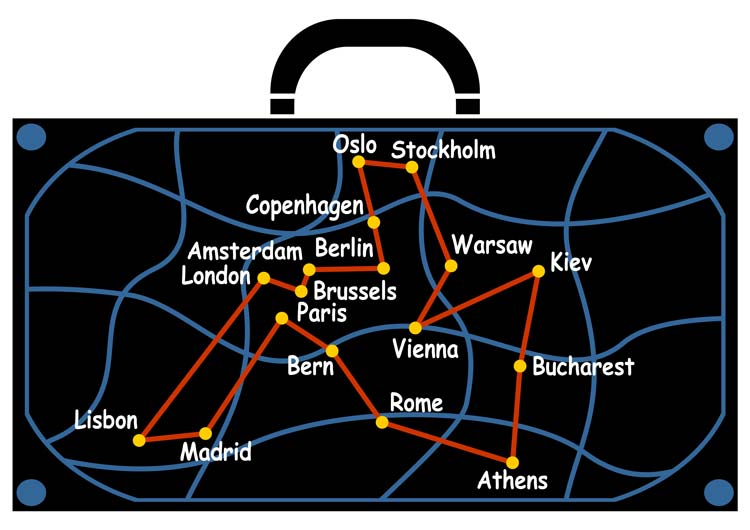Visiting marvelous museums of Paris, sunbathing on the coast of Spain, wandering around atmospheric streets of Cracow, sipping espresso in Italian cafés or trekking in magical mountains of Romania – sounds like a dream, doesn’t it? A trip around Europe is on the top of many American travelers’ bucket lists. If you’re among the lucky ones getting ready for the journey, you should be aware of several basic facts. Although Europe appears small on the map, it’s very diverse, and it’s good to acknowledge it before you start planning the trip. Below we list a few useful tips for first-time backpackers on their way to Europe. Keeping them in mind will make both the organizing and the traveling much easier and more fun.
-
Table of Contents
Different Seasons
There can be snow in Norway and warm weather in Spain at the very same time. When packing for a trip, you should mind the climate and its moodiness all around Europe. Even if you’re going to travel only in the summer, crossing a few countries means facing different weather conditions. Make sure to take the right clothes. Always have something light for hot days, a warm sweater for chilly evenings and some equipment that might save you from the rain – no matter whether you’re going to the southern, northern or central part of Europe and even more so if you’re going to cross them all. The weather can turn from hot to rainy any time, especially with the recent climate change.
-
Diversity of languages
Many people all over the continent speak English, but not all of them, so you shouldn’t count on getting by with only this one language. There are over 200 languages in Europe, so we obviously don’t suggest you learn them all, but it’d be lovely (and useful) if you learned how to say “hey,” “cheers,” “thank you” etc. in the languages of the countries you want to visit. Besides, be ready to use some body language, the universal communication tool.
-
The Schengen Zone
If you don’t have a European passport, you can’t spend more than 90 days (within 180 days) in the Schengen Zone. It means after three months in countries belonging to Schengen; you must leave for another three months and only then you can go back. It’s important to remember it if you plan a longer trip around Europe. The Schengen Zone consists of 26 countries, including Austria, Belgium, Czech Republic, Denmark, Estonia, Finland, France, Germany, Greece, Hungary, Iceland, Italy, Latvia, Liechtenstein, Lithuania, Luxembourg, Malta, the Netherlands, Norway, Poland, Portugal, Slovakia, Slovenia, Spain, Sweden and Switzerland. Monaco, San Marino, and Vatican aren’t members, but they do have open borders with countries belonging to Schengen. It’s all not so bad – there’s still a lot of fascinating places to visit outside of the Schengen Zone. After three months of traveling around some of the participating countries, you can go to discover such places as Croatia, Turkey, the United Kingdom, Bulgaria or Romania.
-
Cheap and expensive countries
Prices in Europe can vary a lot. While a beer in an English pub might cost around USD6, in Bulgaria or Serbia you’ll get it for USD1, 5-2. Take it into consideration while planning your trip, especially if you’re traveling on a low budget. As it happens, some of the Europe’s most famous destinations are also the most expensive ones. Many Americans head to France, the Netherlands or the United Kingdom and skip eastern, central and southern Europe. They want to visit London, Paris, Amsterdam and other famous western capitals. There’s nothing wrong about it; these cities are amazing indeed. If you’re on a small budget, you’d be better off adding some more affordable places to your schedule. Poland, Czech Republic, Romania, Albania, Hungary, Slovakia – these are only some examples of cheap destinations, and they are just as captivating as the most expensive ones.
-
Cultural differences
You might be surprised traveling from Iceland straight to Greece – Europe is very diverse culturally. Although the countries share many common, differences are visible as well. Take personal space for example – it means something else for an Estonian and a Spanish person. Being very friendly, chatty, bubbly and loud is completely fine in some parts of Europe, while in others it might be considered a bit strange and overwhelming. You should be yourself, of course, but try to be respectful and understanding as well. When you go to a country, do your best to explore at least a bit of its history, so that you can understand the culture too.
-
Currencies
Euro is the most common currency, but many countries don’t use it, even those belonging to the European Union (yeah, entering the EU doesn’t mean you’ll be able to pay in Euros). Nevertheless, you can always exchange it for local currencies. American dollars are also excellent, and there’s usually no problem with exchanging it, yet Euro’s are still a better bet.
-
The misleading size
When you look at the map, you might think Europe’s just a tiny piece of the world. It is indeed, but there are over 50 countries, each one of them having a history, a set of customs and cultural characteristics. There’s a lot to discover in Europe, from bustling capitals and historic cities to national parks and charming villages. Take your time to enjoy. Sometimes it’s better to include fewer places in your plan and see them than to rush from one town to another without having a moment to rest, breathe in and soak up the unique atmosphere.
Which places in Europe would you like to visit the most? Let us know! And don’t forget to share this article with your friends, especially if they’re planning a trip to Europe!




